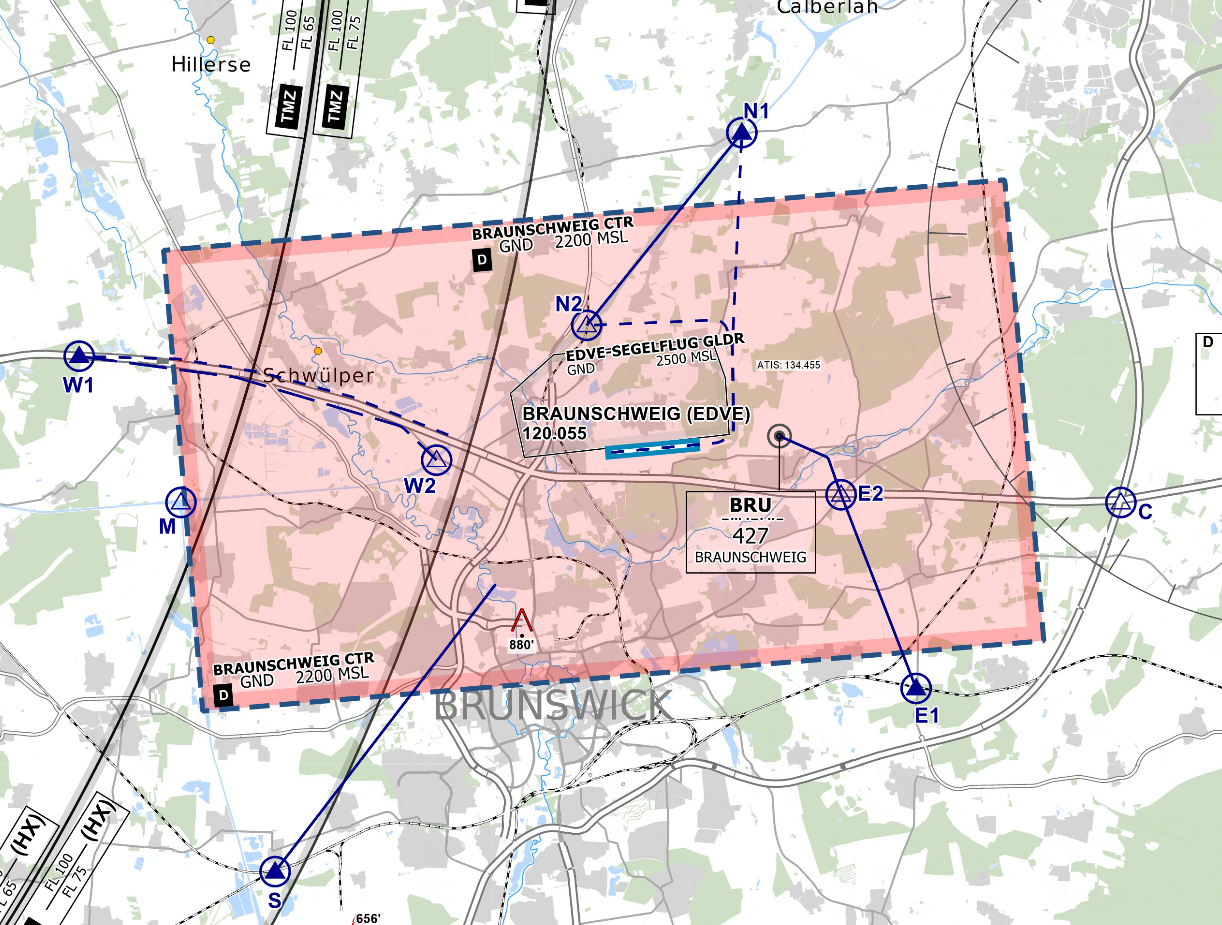SOP Braunschweig Tower
Braunschweig Tower is responsible for all arriving and departing traffic. The top level of the airspace D control zone is 2200ft MSL. Above this altitude and around the CTR airspace E covers the area within responsibility of Bremen Radar (Hannover Approach). A Para jumping Area up to FL100 is directly above the airport.
 Controlzone and VFR Reporting Points of Braunschweig Airport - © openflightmaps.org
Controlzone and VFR Reporting Points of Braunschweig Airport - © openflightmaps.org
Runway and Airport
Braunschweig Airport has a 7546ft (2300m) long single runway (08 / 26) with no Low-Visibility equipment, as well as grass glider strip north of the main runway. The airport features an apron area south of the runway with a main terminal building and various company facilities.
The area limit of ATC competence, which is shown on some charts, is not applicable on VATSIM, as we do not simulate airport operators. Because VATSIM has the Top-Down principle, _IFR Clearances shall be given by the tower, contrary to real-life procedures, where IFR Clearances are given by Bremen Radar.
Departures
All IFR Departures need a Departure-Release from Bremen Radar!
Coordinate early enough on TeamSpeak, as you might get a delay time, e.g. at EDDV events.
Departure Holding points are C (08) and A (26). Airliners usually also backtrack while lining up via C. Intersections D and B are only used to vacate the runway after a landing.
Spacing: Departures shall be separated with a minimum of 3 nm or wake turbulence separated, whichever is greater. When two aircrafts have the same SID waypoint the separation shall be increased to 5 nm or wake turbulence separation whichever is greater.
Auto-Handoff: Pilots shall contact Bremen Radar immediately after take-off without a specific handoff.
Arrivals
Unless pilots request a specific location (e.g. Facilities at Taxiway H or F), they should get a taxi instruction leading to the Apron south of C with a stand of choice. Example: "Taxi to stand of choice via A and C"
VFR
Helicopters
Helipad: The Helipads are not in use. They are turned off via NOTAM for years now. All Helicopters air-taxi to the runway.
Police and Rescue helicopters: Expect Lower Saxony's state police helicopters from the Base in Gifhorn or Hannover. (Bundespolizei, Callsign Phoenix) as well as possible crossings from Christoph Niedersachsen (CHX86).
Low Visibility
As Braunschweig has no special low visibility equipment, Pilots need to adhere to the minimum RVR according to their approach charts. Departures are possible unless RVR is lower than 300m.
Ground
Parking
Taxiways
Delivery
Delivery Service is responsible for all departing flights under IFR. In Braunschweig (and at all other airports of RG Bremen), filed flight plans are generally checked and corrected with regard to the following criteria. To be considered are:
- requested flight level (RFL) even/odd
- restrictions for certain destinations/SIDs
- rough validity of a flight plan
Initial climb clearance: The initial climb clearance at Braunschweig Airport is 4000ft on all published departure procedures. The altitude shall be entered as cleared altitude (CFL) in an appropriate list or tag.
PDC: The use of PDC (Pre Departure Clearance) is permitted in Braunschweig, but not mandatory. The code "EDVE" shall be used.
SIDs and Restrictions
| EDDV | all | max. FL100 | coordinate with Bremen Radar |
(see above) |
LoA and Airways | ||
| SID | 26 | 08 | Climb |
|---|---|---|---|
| BATEL | 6G | 5U | 4000ft |
| DIRBO | 8T | 7U | 4000ft |
| HLZ HEHLINGEN | 7T | 7U | 4000ft |
| DLE LEINE | 7T | 7U | 4000ft |
| NIE NIENBURG | 8T | 7U | 4000ft |
| NORTA | 8T | 6U | 4000ft |
| POVEL | 7W | 5U | 4000ft |
In Braunschweig all SIDs are designed without speed or level restrictions, thus the phrase “via SID” shall not be used.
All SIDs can be flown with RNAV and NON-RNAV capabilities. Keep that in mind when Pilots request a vector-departure, because their "FMC does not handle SIDs" or is "unable for RNAV waypoints".
Specials
Vectored departures: The use of vectored departures requires prior coordination with the responsible radar station. An initial altitude to climb shall be provided.
IFR local flights: IFR local flights are coordinated with the responsible radar controller, who may instruct a different departure procedure, possibly vectored departures.

